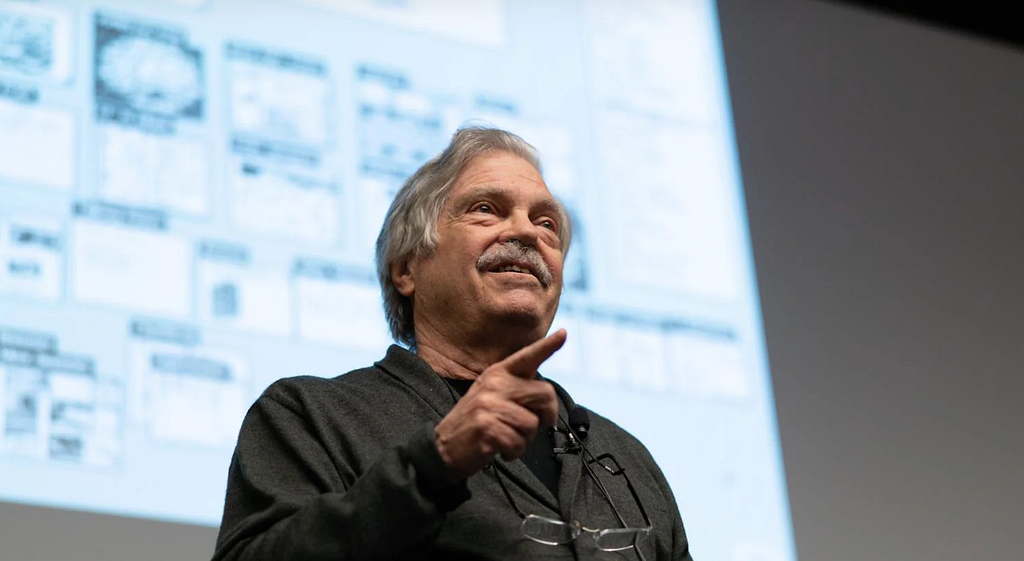Computing pioneer Alan Kay is known for his pioneering work on object-oriented programming and the windowing graphical user interface that served as the foundation for Apple and Windows. But what sets him apart is a combination of creativity, engineering, and a perspective-taking approach to the world in general.

Ever since I started in UX, I got interested in the history of HCI and its roots. This led me to learn about Alan Kay. He’s a pioneer in Computer Science who played a big role in creating the ideas behind today’s object-oriented programming languages. He led the team that made Smalltalk, and he also made fundamental contributions to personal computing. He was among the first to represent objects in a computer as pictures — a metaphor that he further extended by developing the concept of object orientation.
What I appreciate most about him is his open-mindedness and ability to think beyond his own field. He has a special mix of philosophy, science, and art that he applies to engineering, business and understanding the world.
What can we learn from Alan Kay?
Change perspective and question status quo.
Something that seems obvious but is so rare — change how you look, change what you create, change your view, even if it’s uncomfortable, don’t just stick to the obvious.
“A change in perspective is worth 80 IQ points.”
Kay’s groundbreaking work in computer science, including his pioneering contributions to graphical user interfaces and object-oriented programming, was rooted in his ability to perceive problems through different lenses. He even refers to himself as “still trying to learn how to think better”. Alan Kay tells us to be curious and think deeper, to question what we already know and what seems obvious. When we question ideas and tackle issues from various sides, we find hidden chances, new and fresh answers. This approach isn’t just for tech, it sparks innovation in anything.
“School is basically about one point of view — the one the teacher has or the textbooks have. They don’t like the idea of having different points of view.¨
Think about whether the current situation comes from studying, habit, luck, past events, or existing resources. Or, maybe it’s time to question what we know and suggest a new solution that’s simply better and will make out lives easier. This is how real innovation happens, otherwise, we’re just repeating what we already know.
Open up to different fields, be curious, explore.
Alan Kay often uses ideas from other fields to help people make breakthroughs in technology. This is partly influenced by his background. He was exposed to many different cultures and influences. His journey has been quite remarkable, spanning across biology, mathematics, and computer studies. He’s also a talented musician, and he frequently speaks about the profound importance of fine arts in his lectures. Kay believes that embracing a broad spectrum of knowledge can elevate our thinking, inspiring us to generate great ideas rather than just good ones.
“I’ve always thought that one of the reasons the 60s was so interesting is that nobody was a computer scientist back then and everybody who came into it with lots of other knowledge and interests then they tried to figure out what the computers were and the only place they had to use for analogies were other areas and we got some extremely interesting ideas from that.”
The common saying “thinking outside the box” gets a new meaning when we think about the advantages of exploring not just hobbies, but also our knowledge beyond our main job. Find hobbies you love, even if they don’t seem connected to your work at first. Be open to new things and explore different interests. This knowledge, rather than being confined to one field, can serve as an endless wellspring of inspiration and even unconsciously be a source of new ideas.
Appreciate art
In an unexpected twist from the world of computer science, Kay has a unique perspective on art — one that goes beyond the canvas and museum walls. According to him, art isn’t confined to mere images but it holds a deeper value. He suggests that individuals, even those immersed in the world of algorithms and codes, should aim to build a strong foundation in liberal arts. It’s like laying a solid groundwork that opens doors to countless possibilities. It’s not only about computers; it’s also about mixing science and art together to come up with new and exciting things.
“Students who are interested in going into science and engineering have to realise that both those are art forms. Both of them are sterile exercises without an aesthetic feeling. The liberal arts are the best place to develop your aesthetic feeling“
This perspective resonates strongly with me, as I firmly believe that art isn’t an exclusive domain for artists alone. Instead, it serves as a gateway that expands our perception of the world. When we experience art, we can see things in a new way, learn different ways of doing things, learn about the past, and think about things that might not seem connected at first. Essentially, art is like a teacher that helps us see better and understand more.
Few videos worth seeing and articles worth reading
Alan Kay’s contributions offer invaluable lessons to designers and programmers. His innovative mindset, questioning norms and embracing diverse fields, underscores the power of new perspectives. Designers and programmers can learn a lot from him by being creative and skilled at the same time. As things keep changing in design and programming, Alan Kay’s ideas help us know how to imagine and create new things in the future. If you want to learn more, here are a few videos worth seeing to dive deeper into his inspiring thoughts:
To watch:
Doing with Images Makes Symbols (1987)
“The Dynabook — Past Present and Future” (1986)
Arthur Koestler on Creativity and Outlaw Thoughts (1995)
The computer revolution hasn’t started yet (1997)
TED Talk: A powerful idea about ideas (2007)
Power of Simplicity (2015)
Conversation with Vishal Sikka at the CHI Conference (2016)
Making Progress (2021)
To read:
The Laptop Celebrates 40 Years
The man who made computers personal
The Father Of Mobile Computing Is Not Impressed

Questioning status quo: lessons from Alan Kay was originally published in UX Collective on Medium, where people are continuing the conversation by highlighting and responding to this story.


Leave a Reply